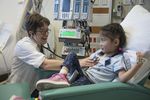Research Matters - Le Bonheur Children's Hospital
←
→
Page content transcription
If your browser does not render page correctly, please read the page content below
Research
Matters
Summer 2021
Competition after COVID-19
Cardiologists show heart damage in athletes unlikely after COVID-19 infection
Le Bonheur’s Sports Cardiology team (left to right) Ryan E. Stephens, NP-C, MBA, Jason N. Johnson, MD,
MHS, Ranjit R. Philip, MD, Ann Hyde, RN, and Benjamin S. Hendrickson, MD
Cardiovascular imaging demonstrated no evidence of myocardial injury or myocarditis
in athletes following COVID-19 infection, according to a research letter published in
Circulation by Le Bonheur Children’s Hospital and University of Tennessee Health Science
Center cardiologists. The screening and evaluation was conducted by Le Bonheur Heart
Institute Sports Cardiology team members Benjamin S. Hendrickson, MD, Ranjit R. Philip,
MD, and Ryan E. Stephens, NP-C, MBA, and Le Bonheur Director of Cardiac MRI Jason
N. Johnson, MD, MHS. Researchers say this study confirms existing recommendations
that cardiovascular screening can be deferred in COVID-19 positive athletes who are
asymptomatic or have milder symptoms.
“Concern for cardiovascular disease as a result of COVID-19 brought about
recommendations for evaluating athletes after infection,” said Johnson. “Our results show
that none of the athletes who underwent cardiac MRI had abnormal findings.”
137 collegiate athletes from three universities were evaluated in Le Bonheur’s sports
cardiology clinic no sooner than 10 days after testing positive for COVID-19. The athletes,
all young adults, compete across the National Collegiate Athletic Association (NCAA)
Divisions 1, 2 and 3 and represent a broad range of sports and various racial ethnic
backgrounds – 48% black, 47% white and 7% Hispanic.
Le Bonheur cardiologists used an algorithm-guided screening to evaluate the
athletes. Regardless of symptoms or illness severity, cardiologists obtained a 12-lead
electrocardiogram, transthoracic echocardiogram and conventional cardiac troponin I
(cTn) level from each COVID-19 positive athlete. If any of these tests were abnormal or
the athlete had a clinical evaluation of concern, they were referred for cardiac MRI (CMR).
Athletes with normal evaluations and negative tests or negative CMR slowly reintroduced
exercise into their routine and eventually returned to full participation in sports.
Study findings include:
• Most athletes (82%) were symptomatic and experienced mild (67%) or moderate (33%)
symptoms. None of the athletes had severe COVID-19 illness.
• Only five (3.6%) athletes had abnormal testing that required CMR. Of these five, none
had abnormal CMR results consistent with myocardial injury or myocarditis.
• None of the athletes experienced new symptoms or other health problems after
resuming exercise and normal competition.
“On the basis of the outcomes and follow-up in our cohort, it is reasonable to defer
cardiovascular screening in asymptomatic athletes or those with milder COVID-19,” said
Philip. “Cardiac screening, testing and imaging can be guided by the severity of symptoms
and illness in an athlete.”Examining nonstented repair of distal Whitaker named CDC program
hypospadias ambassador, receives grant
Toni Whitaker, MD, professor of
Pediatrics at UTHSC and division chief of
Developmental Pediatrics at Le Bonheur,
has been named state ambassador for
the Centers for Disease Control and
Prevention (CDC) program “Learn the
Signs. Act Early.” This program focuses
on improving early identification of
children with developmental disabilities
and autism, with the goal of providing
Toni Whitaker, MD support to these children and their
families. As the program ambassador for
Tenn., Whitaker has received a $94,000 grant to collaborate
with early childhood programs across the state to promote
Joseph M. Gleason, MD
developmental screening and monitoring.
Nonstented tubularized incised plate (TIP) is safe and
effective for distal hypospadias repair, according to research Pierre, Gosain receive NIH funding for
published by Le Bonheur Pediatric Urologist Joseph M. project on host-fungal interactions in
Gleason, MD, and colleagues in Pediatric Urology. To compare
the complications of nonstented versus stented TIP repair,
Hirschsprung-associated enterocolitis
Gleason conducted a retrospective study of 195 patients who Joseph Pierre, PhD, assistant professor
underwent nonstented TIP repair of distal hypospadias. of Neonatology and Microbiology,
Immunology & Biochemistry at UTHSC,
In hypospadias, the opening of the urethra does not form at and Ankush Gosain, MD, PhD, associate
the tip of the penis. Instead, it forms near the end of the penis professor of Surgery and Pediatrics
(distal hypospadias), along the shaft (midshaft hypospadias) at UTHSC, received an NIH R21 grant
or where the penis and scrotum meet (penoscrotal to model host-fungal interactions in
hypospadias). Hirschsprung-associated enterocolitis
TIP is widely accepted for hypospadias repair, but the use of (HAEC). HAEC is a life-threatening
a stent in TIP has remained controversial. Previous research complication of Hirschsprung disease,
Joseph Pierre, PhD which causes intestinal obstruction in
indicates stents may be associated with some complications,
such as bladder spasms, pain and longer hospital stays. newborns, even following corrective
surgery. Although microbes such as
Gleason and colleagues used their experience with intestinal bacteria have been linked to
nonstented TIP repair of distal hypospadias to investigate HAEC, the precise microbial triggers of
the rates of immediate and delayed complications. They this condition have not been defined.
hypothesized the rates of complications with nonstented TIP Backed by NIH funding, Pierre and Gosain
repairs performed at Le Bonheur would be similar to those of will examine interactions between
stented TIP repairs reported in the literature. gut fungi and immune responses of
5.6% of patients who underwent nonstented TIP repair the intestinal epithelium, which lines
presented with immediate postoperative complications, the small and large intestine of the
including split urine stream, painful or difficult urination, Ankush Gosain, MD, PhD gastrointestinal tract. This research
inability to completely empty the bladder and blood in may shed light on fungal and immune
the urine. Of the original 195 patients, 142 had follow-up contributions to the development of HAEC, thus providing
appointments at an average of 10.5 months after surgery. Of potential therapeutic targets for this devastating condition.
these 142 patients, 8.5% presented with at least one delayed
postoperative complication, including an opening between Pediatric Fellows Research Day
the urethra and perineum, a narrowed opening at the tip of
the penis and separation of the edges of the surgical wound. On May 26, 2021, Le Bonheur, the CFRI and the UTHSC Pediatric
The rates of both immediate and delayed complications were Fellowship Office hosted the inaugural Pediatric Fellows
low following nonstented TIP repair of distal hypospadias. Research Day on Zoom. This virtual event was kicked off with
The delayed complications of nonstented repairs were also a keynote speech delivered by Dennis Black, MD, professor of
comparable to those of stented repairs. These results support Pediatrics and Physiology at UTHSC, scientific director of CFRI,
the safety and efficacy of the nonstented TIP technique for and vice-president for Research at Le Bonheur.
distal hypospadias repair. Patient anatomy often dictates
whether a stent should be used, and more complex repairs Eight pediatric fellows across multiple pediatric subspecialties,
may contribute more to the development of delayed including cardiology, endocrinology, neonatal-perinatal
complications than the use of a stent. medicine, nephrology, pulmonology and surgery, presented
their fellowship research projects. The topics ranged from risk
Assadi, A., Alzubaidi, A. N., Cline, J. K., Sharadin, C., Travis, A.J., factors of acute kidney injury in children with COVID-19 to a new
Marley, K., Dewan, C., & Gleason, J. M. (2020). Nonstented
scoring system for Hirschsprung-associated enterocolitis. All
Tubularized Incised Plate Distal Hypospadias Repair: A Single
Center 5 Years’ Experience. Urology, 146, 207–210. https://doi. talks are available online at https://tinyurl.com/aje6akjc.
org/10.1016/j.urology.2020.08.014Le Bonheur cardiologists conduct first successful long-term use trial of platelet
inhibitor cangrelor in pediatric patients on VADs
Cangrelor, a novel, intravenous crucial treatment.
P2Y12 platelet inhibitor, can
The study followed seven patients
safely be used as a long-term
at Le Bonheur who had end stage
antiplatelet therapy for pediatric
heart failure and were supported
patients on continuous flow
on continuous flow VADs. The
ventricular assist devices (VADs),
majority of patients were started
according to research published
on cangrelor because of impaired
in Artificial Organs by Le Bonheur
enteral absorption of oral P2Y12
cardiologists and led by former
antagonists or due to an inability
Le Bonheur Pediatric Cardiology
to reach therapeutic goals. The
Fellow Sarah E. Fahnhorst, DO.
median duration of a patient
While previous studies have
receiving intravenous cangrelor
demonstrated viability of
was 43 days.
cangrelor in adult populations,
this was the first study published Patients on cangrelor reached the
on successful long-term use of Former Le Bonheur Pediatric Cardiology Fellow Sarah E. Fahnhorst, DO (at left) therapeutic P2Y12 level in a mean
cangrelor in pediatric patients. of 1.86 days. No cerebrovascular
events occurred while on cangrelor. There were two episodes
“Thromboembolic events and bleeding are major sources
of mild gastrointestinal bleeding, one episode of hematuria
of morbidity among pediatric patients supported on a VAD,”
and one pump thrombosis. The number of these events are
said Fahnhorst. “Cangrelor is short-acting, reversible and
comparable or reduced when compared with statistics from
intravenous, making it a feasible antiplatelet agent in select
previous studies. Adequate platelet inhibition was achieved
pediatric patients.”
quickly and with a much lower dose of cangrelor than
Pediatric patients who are unable to take or do not respond previously reported by the manufacturer.
well to other antiplatelet drug options can safely remain on a
This study showed that cangrelor is a successful, viable, long-
VAD by using cangrelor. This allows for a lower risk of blood
term antiplatelet therapy in select pediatric VAD patients.
clotting or bleeding complications.
Future studies would benefit from a larger sample size with a
For optimal VAD function, pediatric VAD patients require a control group to further evaluate safety and effectiveness in the
delicate balance between combatting blood clot formation pediatric population.
and preventing bleeding episodes. This dilemma has prompted
“Cangrelor addresses some of the major pitfalls of oral
development of new strategies to mitigate risks. In addition,
antiplatelet therapy, including impaired enteral absorption,
20-40% of the population are poor metabolizers of common
reversibility and epigenetic factors,” said Fahnhorst. “As more
antiplatelet drugs and do not have an adequate response to
pediatric patients are placed on VAD support, cangrelor may be
these drugs. Therefore, an alternative option to long-term
a feasible antiplatelet strategy.”
antiplatelet therapy is necessary for patients who need this
IN BRIEF
The new NIH biosketch FDA issues notice of noncompliance with
The National Institutes of Health (NIH) has issued a new ClinicalTrials.gov requirements
biosketch format, which should be used for all NIH grant Under current federal law, researchers are required to register
applications and Research Performance Progress Reports due clinical trials of drug products, biological products and device
on or after May 25, 2021. On Jan. 25, 2022, the NIH will require products on ClinicalTrials.gov within 21 days after the first
use of the new format and may reject or delay applications human subject is enrolled. The summary results for these trials
using the old format. All changes listed below pertain to the must also be submitted no later than one year after the study’s
Non-Fellowship Biographical Sketch: completion date. The FDA recently issued the first Notice
• In Section A “Personal Statement,” mention ongoing and of Noncompliance for failure to submit summary results to
completed research projects from the past three years that ClinicalTrials.gov. The FDA has the ability to issue monetary
you want to highlight. This information previously went in fines and pursue criminal litigation for failure to comply.
Section D “Research Support.”
• The title of Section B has changed from “Positions and If you are runing a clinical trial or plan to conduct a clinical trial,
Honors” to “Positions, Scientific Appointments and Honors.” please ensure that you are in compliance with all federal laws
• Section D “Research Support” has been removed. regarding ClinicalTrials.gov, as the FDA is currently conducting
an audit. Please also note that clinical trials cannot be published
To easily update your biosketch, you can use SciENcv on the in peer-reviewed journals if they are not registered on
NCBI website. You can copy and paste your information into ClinicalTrials.gov.
the relevant text fields on SciENcv, which will create a properly
formatted biosketch that you can download as a PDF or For assistance with clinical research and regulatory matters,
Microsoft Word file. For assistance with your biosketch, please please contact Kerry Moore, CFRI director of clinical research, at
contact Courtney Bricker-Anthony, PhD, CFRI scientific editor, at kerry.moore@lebonheur.org.
courtney.bricker-anthony@lebonheur.org.Linking metabolism with gut mycobiome
normal levels of protein and lacked fiber.
On the standardized diet, gut fungal communities showed
decreased diversity over time and became more homogenous.
However, these fungal communities remained distinct from
one another. On the processed diet, gut fungal communities
also showed decreased diversity over time but converged
and were no longer distinct. The composition of fungal
communities was also markedly different between mice on the
processed diet and mice on the standardized diet.
These changes in gut fungal community composition in
response to the processed diet were linked to changes in body
composition and metabolism. Most mice gained fat mass on
the processed diet. This increased fat mass was associated with
Joseph Pierre, PhD (far right) increased fasting leptin and ghrelin in addition to decreased
resistin; leptin, ghrelin and resistin are hormones associated
Gut fungi may contribute to important aspects of health,
with hunger suppression, hunger stimulation and insulin
such as metabolism and accumulation of body fat, says new
resistance, respectively. Changes in the abundance of two types
research from investigators at UTHSC and Le Bonheur. In the
of fungi, Thermomyces and Saccharomyces, were associated
study published in Communications Biology, Joseph Pierre,
with increased triglyceride concentrations in the blood and fat
PhD, and colleagues explored potential links between the
deposits in the liver.
gut mycobiome (the fungal community of the microbiome),
the environment and metabolism in mice exposed to a This study shows that the makeup of the mycobiome is
standardized or processed diet for eight weeks. Results showed dynamic and responds to environmental and dietary changes.
that changes in the mycobiome could potentially contribute to These findings could have important long-term implications for
increased fat mass and insulin resistance, which are hallmarks conditions such as obesity and diabetes.
of obesity. These findings could have important implications for
Mims TS, Abdallah QA, Stewart JD, Watts SP, White CT, Rousselle
conditions such as obesity and diabetes.
TV, Gosain A, Bajwa A, Han JC, Willis KA, Pierre JF. The gut
The standardized diet had a normal balance of carbohydrates, mycobiome of healthy mice is shaped by the environment and
fat, fiber and protein. To mimic an unhealthy western diet, the correlates with metabolic outcomes in response to diet. Commun
processed diet was high in carbohydrates and fat, contained Biol. 2021 Mar 5;4(1):281. doi: 10.1038/s42003-021-01820-z. PMID:
33674757; PMCID: PMC7935979.
Racial health disparities in Type 1 diabetes and COVID-19 infection
Non-Hispanic black patients with Type 1 diabetes and
COVID-19 were almost four times as likely to present to the
hospital with diabetic ketoacidosis (DKA) compared to non-
Hispanic whites, according to an article published in The
Journal of Clinical Endocrinology & Metabolism by Le Bonheur
Pediatric Endocrinologist Kathryn Sumpter, MD.
The study examined 180 patients with Type 1 diabetes and
laboratory-confirmed COVID-19 from 52 clinical sites, including
Le Bonheur. The objective of the study was to evaluate
instances of DKA, a serious complication of Type 1 diabetes,
and COVID-19 and to determine whether minorities saw
increased risk when controlled for sex, age, insurance and last
hemoglobin A1c (HbA1c) level.
Kathryn Sumpter, MD (right)
“We know that Type 2 diabetes is a risk factor for worse
“A combination of factors related to social and structural risks
COVID-19 outcomes, but less is known about Type 1 diabetes
leads to higher rates of DKA among minority Type 1 diabetes
and COVID,” said Sumpter. “This study allowed us to examine
patients with COVID-19,” said Sumpter. “Social determinants of
the intersection of Type 1 diabetes and COVID while also
health, including income level, education, racial discrimination
determining the racial inequities in DKA for these patients.”
and inadequate health care access, impact these populations
The results of the study show that non-Hispanic black patients with devastating complications.”
with COVID-19 and Type 1 diabetes have additional risk of DKA
According to the study, intervention in these areas is essential
beyond the risks associated with diabetes or minotirty status.
to prevent higher-risk outcomes that disproportionately affect
Non-Hispanic blacks were more likely to present with DKA and
minority populations.
COVID-19 (55%) compared with non-Hispanic whites (13%).You can also read



























































